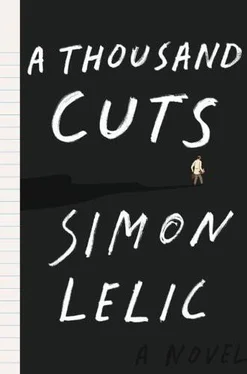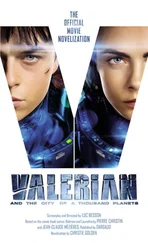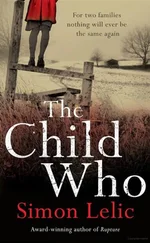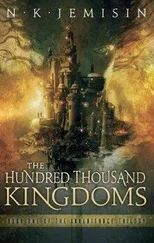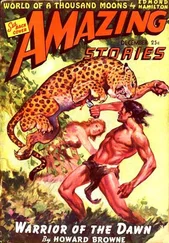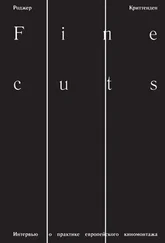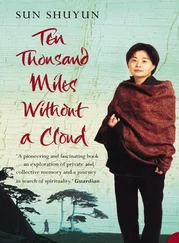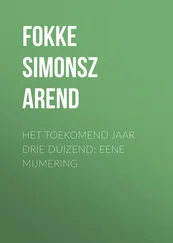There was tape across the doors that led into the assembly hall. The doors themselves were locked. Lucia took a key from her pocket, turned it in the padlock and opened one of the doors. She ducked under the tape and stepped inside.
It smelt of plimsolls. Rubbery, sweaty, the yield of scores of scrabbling feet. The assembly hall, she knew, doubled as the gym. There were climbing frames, folded to the walls and locked in place.
She shut the door behind her, just as he had done. He would have looked to the front, she assumed, at the stage and whomever had been speaking. The headmaster. Travis. Lucia’s eyes, though, caught on the climbing frame opposite her, on the ropes that bisected the rows of bars. One of the victims had hauled themselves upright, had used a rope to try and help them escape the onrush of bodies. There was blood on the knot at the bottom and at intervals for several feet up. At head height the blood marks stopped.
The hall was as it had been all week. Nothing had been moved, other perhaps than by the faltering feet of a photographer. It would have been hard not to bump into something. There was no clear pathway to the stage, nor to the side of the hall across from her. From the rear wall to the podium, chairs lay on their backs, on their sides, any way but the right way up. Many were still laced together so that where one chair had fallen the rest had fallen too, transforming the row into a barrier, the legs of the chairs into barbs. Lucia was reminded of an image of Verdun, of the land and the barricades between the trenches. She imagined children, their eyes bleeding fear, tripping and becoming entangled and then trampled by those behind. She imagined the impact of one of the upended chair legs against a stomach, a cheek, a temple.
On the chairs and under them were jumpers, some books, the contents of children’s pockets. A set of keys here, attached to a chain attached to a belt loop torn from someone’s trousers. An iPod, black, with its headphones still plugged in and its screen cracked. Mobile phones. And shoes. There was a surprising number of shoes. Girls’ shoes mainly but also trainers and boots. To one side a single brogue, size ten or eleven. A pair of glasses, the lenses intact but one arm snapped off. A handkerchief, white.
She tried to ignore the state of the hall and to picture it as he would have seen it: every seat full, the children silent for once given the circumstances of the assembly, some of them crying and trying not to. The teachers seated in rows flanking the headmaster, jaws tense, eyes downcast or fixed on the headmaster himself. Travis at the lectern, his hands on the corners furthest away from him and his elbows locked, his eyes commanding the attention of his audience, his speechifying relentless despite the late arrival to the hall. Travis would have seen him walk through the doors of course. Some of the teachers would have too, though they could not have made out what he was carrying. Children in the back row may have turned, may even have noticed the gun, but they would have assumed, surely, that it was a prop, that his late entrance was staged to coincide with some aspect of Travis’s address. The gun was in keeping with the theme of the headmaster’s sermon after all. Violence was the theme of the day.
She traced his steps as best she could, moving across the rear of the hall and then turning at the corner towards the stage. Halfway along the side wall Lucia stopped and faced inwards, in the direction of where the pupils would have been sitting.
He would have had no skill with a gun. His aim was poor and his prey would have started moving and the gun itself did not fire straight. So Sarah Kingsley, aged eleven, was the first to be shot. As it turned out, she was also the last to die. Lucia wondered if it had registered, his mistake, after he had squeezed the trigger. Whether he had even noticed. Sarah’s blood was at her feet. It was Sarah’s blood, mainly, that she had followed along the corridor. It was Sarah’s blood on the rope.
The first report would have impacted like a brick through glass. The stillness in the hall would have shattered and been displaced by a jagged, piercing panic. The children would have scattered, they would have screamed. He would have tried to remain still, to stand unyielding against the thrashing bodies, to find his aim again. Once more he had fired and once more he had missed his target. Felix Abe, aged twelve, had died instead.
Two from two. The weapon was a museum piece, not a semiautomatic. It was in poor condition. That he killed five, five with six bullets, was in a way a minor miracle. It was the worst kind of luck.
The teachers would have been standing by now, fixated and immobile, like theatre-goers trapped in the circle as chaos consumes the stalls. They would have seen him fire for a third time and they would have seen the third child fall. When he fired again – his fourth bullet, the second one to hit Donovan Stanley, aged fifteen – they might have understood. When he had then looked to them and taken his first step towards the stage, they might finally have run themselves.
Lucia moved to where the final victim – Veronica Staples, the teacher – had fallen, at the base of the steps leading away from the stage. There were more shoes gathered here, piled almost neatly at the bottom step. There was a handbag too, its contents spilled and scattered: a lipgloss with its case cracked; receipts and scraps of paper, marked and muddied by frantic feet; a pen; a whistle threaded with pink ribbon; half a packet of Polo mints.
She turned, checking the ground around her as she did so, and saw where he had fired the sixth round, the last bullet in the barrel, and where his blood had splattered the wall. The plaster, once yellow, was pitted by bullet and bone. There were strands of hair too, clumps of it, where his head had impacted against the wall and slid towards the skirting. She crouched and imagined herself level with him, looking at him, watching the carnage he had created reflected back at her by his unseeing eyes.
Finally she reversed the order, moving to the point where Sarah, the first victim, had been shot. In her mind, the scene unfolded like a DVD playing in reverse. The bullets retreated, the chairs toppled upright, the blood flowed to the place it belonged. Children found their seats, teachers lowered their gaze and Samuel Szajkowski walked backwards and out of the room.
It was warmer outside than in. Stepping out into the playground was like stepping on to a runway in the tropics. The policemen, tall and overweight both, were red cheeked and sweating. They had been chatting, making jokes, and they were grinning as she came through the doors.
‘Find what you were looking for, Inspector?’
Every day the same question. A different uniform but the same question. They thought Lucia enjoyed being here. They thought that was why she kept coming back. But they were asking the wrong thing. She had found what she was looking for – she had found what she had been sent to discover – but she had found out more besides. The question was what to do about it. The question was whether to do anything at all.
Do you have any idea,Detective Inspector May, of the crisis the teaching of mathematics is facing in this country?
Of course not. Why would you?
Do you have a pension, Inspector? Do you have a mortgage? You pay rent, though. Money comes in and money goes out. More out than in, I’d warrant. I do not mean to pass judgement, Inspector, but that tends to be the way. And do you know why? I’ll tell you why. Because most of the adult population in this country can barely count their own toes, assuming for a moment that they can see beyond their bellies to locate them. It has been true since the 1960s and it will remain true for as long as you care to consider.
Читать дальше
